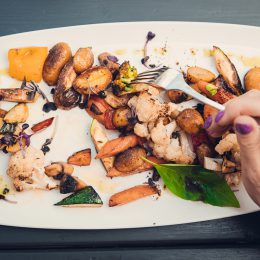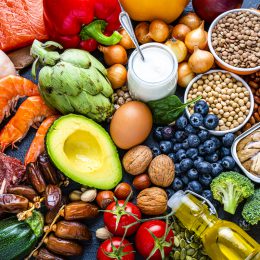8 consejos para comer sano a bajo precio
Adopt these tips to get better nutrition for less.

If you've noticed your grocery bill steadily creeping up, you're in good company. From bread to eggs to meat, food prices have been on the rise in the U.S. In fact, grocery store and supermarket prices increased 1.1 percent in just one month this year (from September to October) and are 5.4 percent higher than they were in October 2020, according to the U.S. Department of Agriculture (USDA).
It's a concerning trend, but it doesn't mean you have to choose between eating healthy and staying within a budget. You can score better nutrition for less with a few simple tweaks to how you shop and prepare food at home. It may require a bit more planning, but we think you'll find it's worth the effort.
Here are eight ways to save money while enjoying a delicious, satisfying, nutrient-packed diet.
Money-Saving Tip #1: Take Stock of What’s Already in Your Kitchen
This is a crucial step for stretching your food dollar that many people skip. Look closely at what's in your fridge, freezer, and pantry before you plan your meals for the week and head to the grocery store. It takes about five minutes and can help you avoid needless food purchases.
"It's especially important to take inventory of foods and ingredients that expire, like produce, fresh meat, herbs, dairy, and other refrigerated ingredients," says Julie Andrews, M.S. She's a registered dietitian nutritionist and owner of The Healthy Epicurean. "If you start by planning upcoming meals around these ingredients, you can save money by limiting food waste."
Once you know which perishable items you want to use up, Andrews suggests taking inventory of non-perishables to see what could complement these foods. Say you come across some cooked chicken breast in the back of your fridge. You could check for a bag of brown rice or another whole grain to pair with it. Whatever you discover, there's a good chance this exercise will help you add fewer items to your grocery list.
Money-Saving Tip #2: Remember, Less Is Less
Many foods are cheaper in their most basic forms. Por ejemplo:
- A solid block of cheese typically costs less than shredded cheese.
- A bag of dried beans is less expensive per serving than canned beans.
- A large bag of plain old-fashioned oats may cost about the same as a few packets of instant oatmeal, plus it lacks the added sugar.
- A bunch of loose-leaf spinach costs less than baby spinach in a plastic clamshell.
We could go on, but you get the idea.
Another good way to save cash is to opt for basic healthy staples such as apples, bananas, and peanut butter over pricier fruits or alternatives such as almond butter, says Lisa R. Young, Ph.D., R.D.N. Young is an adjunct professor of nutrition at New York University and author of Finally Full, Finally Slim.
That’s because the latest trendy “superfoods” often come with higher price tags. While foods such as acai, chia, and spirulina have their merits, more cost-effective stalwarts such as blueberries, flax, and spinach are also rich in nutrients.
“There are no single superfoods, but rather ‘super diets’ composed of lots of different healthy foods that aren’t necessarily as expensive,” Young says.
Money-Saving Tip #3: Embrace Eggs
Eggs aren’t just for breakfast, and at 25 cents to 40 cents a pop, Young says they’re an excellent protein alternative to more expensive meat. “I love a veggie omelet or a spinach frittata for lunch,” she says. You can also use eggs to replace the meat in sandwiches, tacos, or on top of salads.
Eggs provide about 6 grams of high-quality protein each, but they also contain important nutrients, including:
- Choline, an essential nutrient needed to regulate memory, mood, and muscle control
- Lutein, an antioxidant that’s important for eye health and can reduce the risk of cataracts and macular degeneration, two common eye disorders in older adults
- Selenium, a mineral that plays an important role in many processes in your body, including metabolism and thyroid function
Worried about cholesterol? While eggs are high in cholesterol, it’s important to remember that cholesterol in your diet doesn’t necessarily raise cholesterol in the bloodstream. That’s because your liver produces a large amount of cholesterol every day. When you eat more of it, your body compensates by producing less of its own.
If your doctor has recommended watching your cholesterol, check in before making any big changes to your diet.
Money-Saving Tip #4: Take on Meatless Mondays (and Maybe Tuesdays)
It’s hard to ignore that meat has seen some of the sharpest price increases recently, says Alice Figueroa, M.P.H., R.D.N. She’s the founder of Alice in Foodieland.
“As a result, I always recommend spicing up your diet by incorporating more plant-based dishes and snacks,” Figueroa says.
Research supports this budget-friendly swap. A recent study published in The Lancet analyzed eating patterns from 150 countries, including the U.S. It found that diets higher in plant-based foods can be 22 percent to 34 percent less costly in upper-middle-income to higher-income nations, compared with other types of diets.
Figueroa suggests using plant-based proteins such as tofu, lentils, and beans more often. "You can use these to create meals that are well-balanced, affordable, nutritious, and satisfying."
Need ideas on how to use lentils and beans? Check out these simple, surprisingly delicious recipes.
Money-Saving Tip #5: Go Big with Chicken
If chicken is a staple in your diet, consider buying the whole bird - meat, bones, skin, and all. "A whole chicken is more economical than chicken pieces that are already broken down," Andrews says. "That's because there is extra labor involved in breaking that chicken down, so you're paying more for that labor."
How much more? Exact prices vary depending on where you live and shop, but generally a whole chicken costs about $2.29 per pound, while chicken breasts cost about $6.59 per pound.
If the cooking process deters you, here's a simple way to prepare a tasty whole chicken: Preheat your oven to 425° F. Brush the outside of the chicken with olive oil and season with salt and pepper. Stuff a few whole peeled garlic cloves, lemon slices, and herbs of your choice into the cavity. Transfer the chicken to a rimmed baking sheet, roasting pan, or cast-iron skillet. Cross the legs and tie them with twine. Now you're ready to put it in the oven.
Roast until an instant-read thermometer registers 165° F when inserted in the thickest part of the thigh (avoid touching the bone). This translates to about 15 minutes per pound of chicken. If the juices run red, put the chicken back in the oven and check again in five minutes. Let it rest 10 minutes before carving.
If you’ve been buying chicken breasts, get ready to enjoy juicier, more flavorful meat.
Money-Saving Tip #6: Pick Produce That’s in Season
You may have noticed that strawberries and cherries are cheaper in the summer or that butternut squash is a steal in the fall. That's because produce typically costs less when it's in season and therefore abundant. When certain items aren't in season, they must be shipped from distant farms where growing conditions are more ideal. The cost to transport out-of-season produce is passed onto you, the consumer.
For this reason, Andrews recommends filling your daily vegetable quota with whatever is in season. Her top pick for fall and winter? Root vegetables.
Suscríbase a nuestro boletín informativo
Es rápido y fácil: Usted podría estar entre las 13 millones de personas elegibles.
¿Ya es miembro? Haga clic para descubrir nuestros más de 15,000 centros participantes.
Síganos
“Sweet potatoes, beets, carrots, rutabaga, parsnips, and turnips, to name a few, are inexpensive vegetables that can be used to make soups, side dishes, casseroles, and even breakfast dishes like breakfast hash,” she says.
Plus, some root vegetables, including potatoes and carrots, can be purchased in bulk, which helps reduce the cost even more, Andrews adds. Root vegetables also have a longer shelf life than more delicate vegetables such as broccoli or lettuce. That means you don't have to worry as much about spoilage sending your money straight into the compost bin.
Check out the USDA’s guide on which fruits and vegetables are in season now.
Money-Saving Tip #7: Take Advantage of Frozen Foods
When it comes to budget-friendly meal prep, frozen fruits and vegetables are the gift that keeps on giving. That's especially true if you want to keep enjoying your favorite produce year-round without breaking the bank. (Blueberries in the winter, anyone?)
There’s a common misconception that frozen fruits and veggies aren’t as nutritious as their fresh counterparts, and Figueroa is determined to put that to rest. Fruits and vegetables that will be frozen are picked at peak ripeness, when they’re the most nutritious. Then they’re flash-frozen and packaged within hours. This means you don’t lose out on nutrient content when you choose frozen, and “some studies have shown they may have even higher amounts of certain nutrients like vitamin C,” Figueroa says.
Frozen foods also come in handy if you're cooking for just one or two people. You can use what you're going to eat and then pop the rest back in the freezer, safe from spoiling for several months.
In addition to fruits and vegetables, you can also save big on vacuum-sealed, frozen fish fillets such as salmon and cod. They're often priced lower for the same quality, and you can buy more at once to use in healthy meals for several weeks.
Money-Saving Tip #8: Watch Out for Label Lingo
"Foods labeled with healthy-sounding catchphrases often cost more and may deceive you to think the product is healthier than it is," Young says. "There's even a name for this: health halos."
Packages with phrases such as hormone-free, free-range, antibiotic-free, gluten-free, and all natural often come with a higher price tag on anything from meats to cereals. But these terms often lack any real muscle and aren't worth the extra cost.
"It's important to realize that claims on food labels are frequently about marketing, not health," Young says. For example, "natural" or "organic" candy and cookies are still candy and cookies. It's important to do your label research and figure out which business practices you believe are worth splurging on and which are just costly green- or health-washing.
If you’re concerned about environmental issues and possible chemical residues on foods, you may decide it’s worthwhile to spend more on organically certified fruits and vegetables. But you can rest easy knowing that not all non-organic foods are dangerous. Choose organic produce when you can, focusing on foods from the Environmental Working Group’s Dirty Dozen list and cutting yourself some slack with the Clean Fifteen list.
¡Tome en línea sus clases favoritas de SilverSneakers!
SilverSneakers members can access live fitness classes and wellness workshops through SilverSneakers LIVE. See the latest schedule and RSVP for classes here.
¿No es miembro? Si usted tiene un plan de Medicare, este puede incluir SilverSneakers sin costo adicional. Verifique su elegibilidad al instante aquí. .





